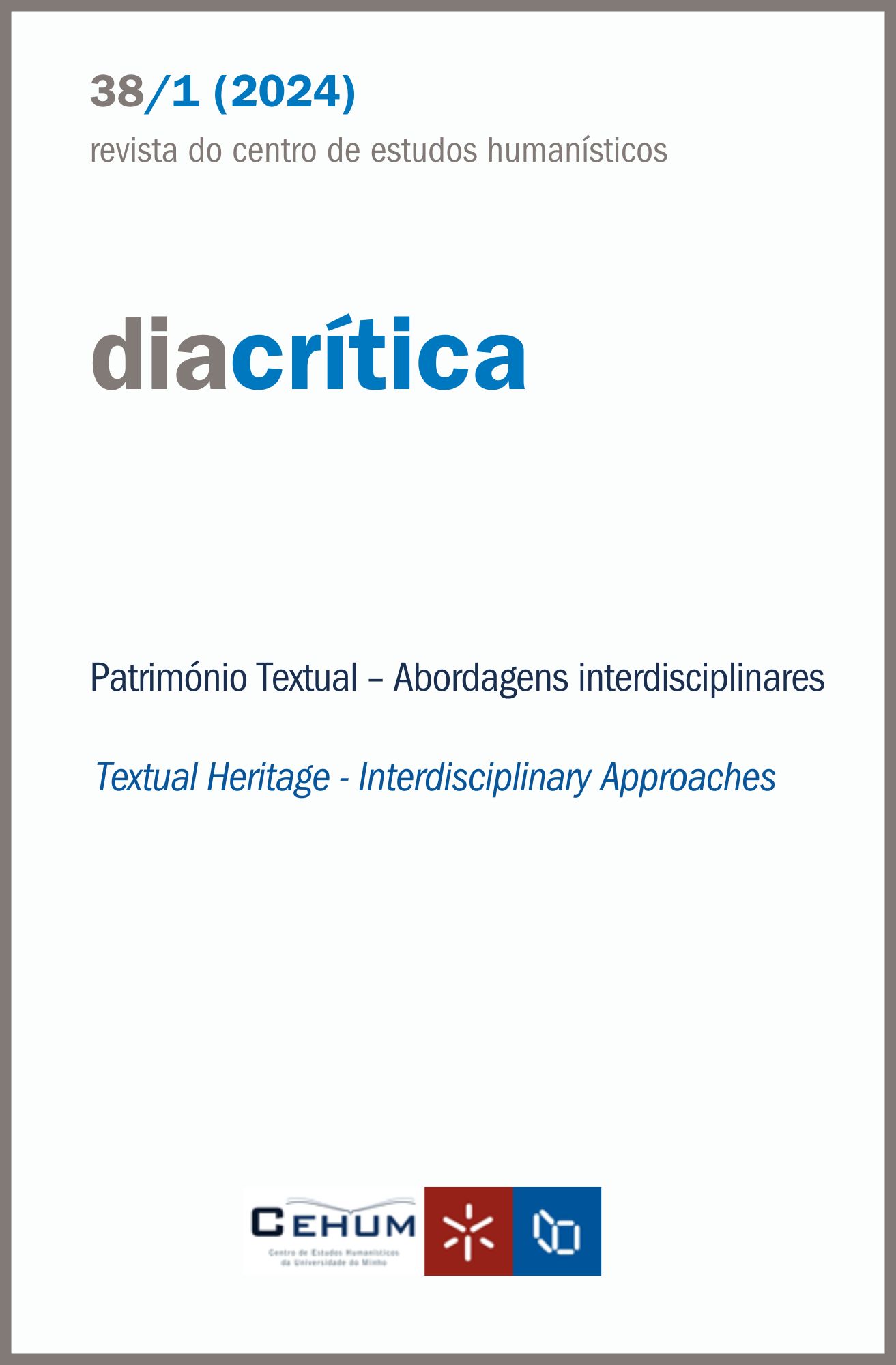The figure of the Mandarin in a manuscript dictionary of Portuguese and Chinese from the 18th century
DOI:
https://doi.org/10.21814/diacritica.5759Keywords:
Lexicografia português-chinês, História do léxico chinês, Filologia portuguesa e chinesaAbstract
This work is based on a handwritten Portuguese-Chinese dictionary dating from the 18th century, an unpublished codex from the National Library of Portugal whose edition we prepared in recent years, in which numerous entries related to Mandarins were included, as well as specific Chinese equivalents for the same. This set of entries is very informative regarding what mandarim (Mandarin) was considered to be, its various types, procedures, careers, utensils, privileges, family, etc., in many cases deserving its own word, exclusive to mandarins or those of similar classes or higher. Comparison with later lexicographical and grammatical works of Joaquim Afonso Gonçalves reveals a curious disappearance of this type of information in the following century, with the term mandarim (Mandarin) itself being ignored in favor of others as opaque and general as empregado (employee), or less precise synonyms than seem to have served to avoid the use of that lexeme, as ministro (minister) and magistrado (magistrate).
References
Academia Chinesa de Ciências Sociais (2016). Xiàndài Hànyǔ Cídiǎn [Dicionário de Chinês Contemporâneo] (7.ª ed.). Commercial Press.
Bluteau, R. (1712–1728). Vocabulario portuguez, e latino... Collegio das Artes da Companhia de Jesu/Officina de Pascoal da Sylva.
Bluteau, R., & Morais Silva, A. (1789). Diccionario da lingua portugueza composto pelo padre D. Rafael Bluteau, reformado, e accrescentado por Antonio de Moraes Silva.... Simão Tadeu Ferreira.
Chang, Y.N. (2014). Míngqīng shíqīde cháojìn kǎochá [Inspeção e audiência na corte imperial nas dinastias Ming e Qing]. Historical archives, 2, 51–56.
Cao, X. (2015). Hónglóumèng [Sonho do pavilhão vermelho]. 21st Century Publishing House.
Dalgado, S.R. (1919–1921). Glossario luso-asiático (2 vols.). Imprensa da Universidade/Academia das Sciências de Lisboa.
Feng, S. (2016). Zhōngguó gǔwénzìxué gàilùn [Introdução à Paleografia Chinesa]. China Social Sciences Press.
Gonçalves, J.A. (1829). Arte china, constante de alphabeto e gramática. Real Colégio de São José.
Gonçalves, J.A. (1831). Diccionario portuguez-china. Real Collegio de S. Jose.
Gonçalves, J.A. (1833). Diccionario china-portuguez. Real Collegio de S. Jose.
Guan, H.Q. (s.d.). Húdiémèng [Sonho de borboleta]. Yuánqǔ Xǔan [Antologia de Versos da Dinastia Yuan]. vol. 29, pp. 9-10. https://archive.org/details/02111109.cn/page/n1/mode/2up.
Hao, X.J. (2005). “Lěichén” Biànxī [Discriminação do termo leichen]. Modern Chinese, 9.a ed., p. 10.
Huang, H.X., & Chen, F. (2005). Zhōnɡɡuó Fènɡlù Zhìdù Shǐ [História do sistema de ordenados na China] (2.ª ed.). Wuhan University Press.
Lan, L.X.X.S. (1963). Jīn Píng Méi Cíhuà [A Ameixeira no Vaso de Ouro]. https://archive.org/details/20210211_20210211_0714/page/349/mode/2up
Li, D.Y. (Ed.) (1989). Ming Hui Dian [O controlo dos mandarins] (tomo 20). Zhong Hua Book Company.
Li, F. (Ed.) (983). Tài Píng Yù Lǎn [Enciclopédia da era Taiping]. https://ctext.org/zhs
Ling, M.C. (1632). Èrkè Pāi Àn Jīngqí [Surpreendido ao bater na mesa]. https://ctext.org/zhs
Luo, Z.F. (Ed.) (1986–1993). Hànyǔ Dàcídiǎn [Grande dicionário da língua chinesa] (vols. 1–12). Shanghai Cishu Chubanshe.
Mao, P.Q., & Chen, J. l. (1995). Míng qīng xíngzhèng guǎnlǐ zhìdù [Sistema de gestão administrativa Ming e Qing]. Shanxi People Publishing House.
Mu, T.J. (2017). Shìdàfū de Yuánliú — Rúshēnɡ [A origem da classe Shidafu — Rusheng e Wenli]. Comprehensive Reading for Students, 29, 46–47.
Shi, N.A., & Luo, G.Z. (2005). Shuǐ Hǔ Zhuàn [Margem da água] (2.a ed.). People’s Literature Publishing House.
Wang, C. (Ed.) (1991). Zhōnɡɡuó Yànyǔ Cídiǎn [Dicionário de provérbios chineses]. Shaanxi Sanqin Publishing House.
Wang, Q.Z., & Wu, G.H. (2013). “Bàiɡuān” Xīnquán [Uma nova visão do Baiguan]. Journal of Nanjing University (Philosophy, Humanities and Social Sciences), 50(3), 129–138.
Wang, X. (2016). Tángwǔdài Hànlín Dàizhāo Kǎolùn [Estudos sobre os Daizhao da Academia Hanlin na Dinastia Tang e no Período das Cinco Dinastias] [Tese de Doutoramento, Universidade Normal de Beijing].
Witek, J.W. (Dir.) (2001). Dicionário português-chinês, Michele Ruggieri & Matteo Ricci. Biblioteca Nacional de Portugal/IPOR/Ricci Institute for Chinese-Western Cultural History.
Wu, J.Z. (2018). Rúlín Wàishǐ [História dos letrados]. People’s Literature Publishing House. (Original publicado em 1750)
Verdelho, T. (2008), O encontro do português com as línguas não europeias: Exposição de textos interlinguísticos. Biblioteca Nacional de Portugal.
Yan, S.G. (1986). Hàn shū zhù [Explicação do Livro de Han], vol. 30. Shanghai Classics Publishing House.
Yang, Y.F. (2013). Zhongkuo fazhishi gaiyao [Introdução à história do Direito chinês]. China Social Sciences Press.
Zhang, X.S. (2013). “Zuòɡuān Fācái” Chuántǒnɡ Héyǐ Miányánbùjué [Por que não acaba a tradição de se ser oficial para se ficar rico]. Tribune of Social Sciences, 8, 173–180.
Zhang, Y.S. (Ed.) (2002). Kāngxī Zìdiǎn [Dicionário de Kangxi]. Hanyu Dacidian Chubanshe.
Zhao, E.X. (Ed.) (1977). Qīng Shǐ Gǎo [Esboço da história da Dinastia Qing]. Zhonghua Book Company. (Original publicado em 1929)
Zwartjies, O. (2011). Portuguese missionary grammars in Asia, Africa and Brazil, 1550-1800. John Benjamins. DOI: https://doi.org/10.1075/sihols.117
Downloads
Published
How to Cite
Issue
Section
License
Copyright (c) 2024 Anabela Leal Barros, Ana Ng Cen, Xiao Wang

This work is licensed under a Creative Commons Attribution-NonCommercial 4.0 International License.










